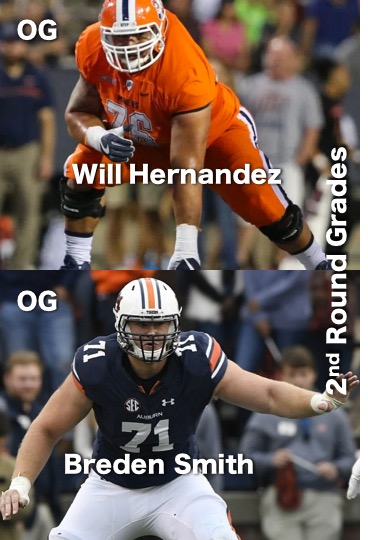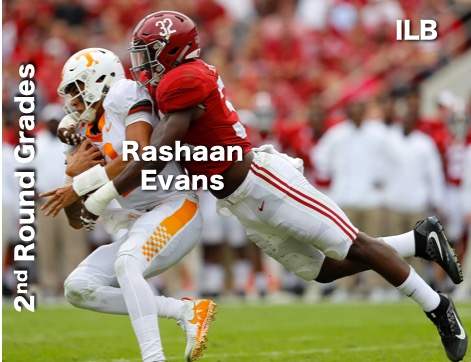The NFL combine is finally here! While it officially starts today, don’t expect to see significant workout numbers till Friday. Early parts of the combine will be dedicated to medical and psychological tests, as well as physical measurements. Arrowhead One has you covered with what to look for, each day of the combine and how to interpret that info. Let’s get right into it.
NFL Combine Phases
Phase 1: Combine scheduling is broken down into groups and phases. In phase 1, players register, do orientation, get x-rays, do overflow testing, and start interviews with teams.
What To Watch For: Watch twitter, or the daily thread here for tweets. As teams interview players and x-rays are done, details will leak out. Details that can make players rise or fall in the draft.
Phase 2: Player continue overflow testing and team interviews. They also get a thorough medical examination. Players will also get their measurements done, in this phase. Hand size, arm length, height, weight etc.
What To Watch For: Measurements are the most important thing. I’ll delve more into what to look for with those in the position groups. Suffice it to say, a player being an inch too short, or 10lbs too light can have a major impact on their draft position.
Phase 3: Players will undergo psychological testing, meet with the NFLPA, talk to the media, and do bench press. This phase is teams‘ last chance to interview prospects, at the combine.
What To Watch For: The bench press is more important for some positions than others, but it’s the biggest thing to examine, in this phase. Psychological testing doesn’t often have a huge impact on draft stock, but it can. Keep your eyes open for rumors.
Phase 4: This is the meat and potatoes of the combine: the on-field workouts. Everything from 40 times, to position specific drills happens here.
What to Watch: Numbers are important for every player, but especially guys from smaller schools. NFL.com will have a workout tracker that’s sort-able. This is indispensable for the amateur draft guru. Use it to see who posts the fastest times in each drill for each group.
NFL Combine Position Groups
Group 1: Punter/Kicker, Special Teams, OL: The OL is broken up into two groups, so I’ll focus on them in a moment. Punters and kickers don’t really need to post many notable measurements or numbers at the combine. They need to interview well and do a good job in the STs specific workouts. Long snappers need to do this as well, but their measurments are slighly more critical. A LS needs to be big enough, and fast enough, to make tackles on STs. Look for FB type numbers from that group.

Group 3: RB: The running back position is all about explosion. Look for players with vertical jumps of at least 35” and Broad jumps of 10′ (120”) or more. 40 time for RBs needs to be not much slower than 4.6. Look for good height weight combos: guys who are around 5’10” and weigh over 210 lbs. Running backs who weigh 200lbs or less will raise durability concerns.
Group 4 & 5: QB & WR: For QBs, most of teams‘ evaluation will be based on their college tape. However, height is very important for QBs. Guys under 6’2” are not, generally, considered viable starters. Hand size is also a factor. Look for guys with 9.5” hands or bigger. Chiefs own Patrick Mahomes has slightly small hands at 9.25”, so it’s not the be all end all, but it is a factor. Especially for small QBs. Drew Brees and Russel Wilson both have over 10” hands. Also look at height weight combos. If a guy is 6’2” or 6’3”, he needs to be at least 220lbs. After that, I’d say, add about 10lbs for every inch taller than 6’3, with a maximum required weight of 250lbs (though more is fine).
WR: For WRs, things are somewhat relative. Bigger WRs don’t have to be quite as fast, smaller WRs don’t have to be quite as strong. If you’re looking for one defining factor, look at the difference between their 40 time and their 20 yard shuttle. For WRs, with great change of direction, the shuttle time will be .4 less, than their 40 or better. Now this applies to players running in the 4.4 40 range or slower. Guys faster than that just need to post around 4 seconds in their shuttle. Big hands and long arms will help a prospect’s draft stock, as will good explosion numbers (vertical, broad jump), but nothing is bigger than that shuttle time.


3-4 OLB: Some OLB prospects will likely be included in this group and some with the LBs. I’ll cover bother here. Look for similar strength and length requirements, to DL, but better broad jump numbers. Look for 10′ or better from these guys. OLBs also have to be more fluid than DL, and able to cover TEs. They need 3-cone drills of 7 seconds or better, and 40 times not slower than 4.8.


Jaire Alexander is a cornerback who’s also a second round talent with skills:
Jaire Alexander has injury concerns. He also has the ball skills the Chiefs now desperately need. #ChiefsDraftmas pic.twitter.com/kCP1weYeFa
— Kent Swanson (@kent_swanson) February 27, 2018
Arm length is key (31” or better is good). CBs can’t be too slow, times slower than 4.5s are generally not acceptable. Ultimately, much of CB comes down to technique and instincts. Don’t get caught up in admiring an athletic specimen, at CB, if he never had interceptions in college.

NFL Combine Schedule
- Today: Groups 1, 2 & 3 begin phase 1.
- Wednesday: Groups 1, 2 & 3 begin phase 2. Groups 4, 5 & 6 begin phase 1.
- Thursday: Groups 1, 2 & 3 begin phase 3. STs specific drills start. Groups 4, 5 & 6 start phase 2. Groups 7, 8 & 9 begin phase 1.
- Friday: Groups 1,2 &3 begin combine workouts. Groups 4, 5 & 6 begin phase 3. Groups 7, 8 & 9 begin phase 2. Groups 10 & 11 begin phase 1.
- Saturday: Groups 4,5 & 6 begin combine workouts. Groups 7, 8 & 9 begin phase 3. Groups 10 & 11 begin phase 2.
- Sunday: Groups 7, 8 & 9 begin combine testing. Groups 10 & 11 start phase 3.
- Monday: Groups 10 & 11 do combine testing.
If you want to know more about the combine than I’ve covered here, you have a problem. Also, shoot me a question in the comments and I’ll do my best to hunt up a satisfactory answer. After a whole lot of upheaval, it’ll be nice to talk about something a little less polarizing. Go Chiefs. Win the draft, fix the defense. Thank you.
If you are viewing this in Apple News and would like to join the Discussion, [GO HERE.](http://arrowheadone.com/information-overload-combine-info-for-the-obsessed-chiefs-fan/#disqus_thread)


